Calcium Carbonate Growth with the Ring Structure of Stalactite-Type Minerals in a Tuff Breccia
Abstract
1. Introduction
2. Materials and Methods
2.1. Materials
2.2. Strength and Morphology of Stalactite Minerals, and Properties of Spring Water
2.3. pH Values and Microstructures
2.4. Mineral Classification
2.5. Carbon and Nitrogen Stable Isotope Ratios
2.6. Mass Spectrometry
3. Results
3.1. Strength and Morphology of Stalactite Minerals, and Properties of Spring Water
3.2. pH Values and Microstructures
3.3. Mineral Classification
3.4. Carbon and Nitrogen Stable Isotope Ratios
3.5. Mass Spectrometry
4. Discussion
5. Conclusions
- (1)
- Stalactite minerals are potential diatom stalactites and have ring structures where biomediated calcium carbonate exists in the interstices. The existence of microorganisms and their metabolism significantly contribute to the formation of stalactite minerals.
- (2)
- The interstices between the rings are filled with calcium carbonates; thus, the strength of the stalactite minerals is expected to increase steadily. Diatoms and green algae should also facilitate the generation of calcium carbonate.
- (3)
- Stalactite minerals are mainly composed of quartz, calcite, vaterite, and epsomite; however, silica, calcium, and magnesium are obtained from spring water.
- (4)
- Since the mass spectral signals of the demineralized samples include phenylalanine, the origin of the calcium carbonate minerals in the stalactite minerals is microbiological.
Author Contributions
Funding
Data Availability Statement
Acknowledgments
Conflicts of Interest
References
- Konhauser, K. Introduction to Geomicrobiology; Blackwell Publishing: Oxford, UK, 2007. [Google Scholar]
- Büdel, B.; Weber, B.; Kühl, M.; Pfanz, H.; Sültemeyer, D.; Wessels, D. Reshaping of sandstone surfaces by cryptoendolithic cyanobacteria: Bioalkalization causes chemical weathering in arid landscapes. Geobiology 2004, 2, 261–268. [Google Scholar] [CrossRef]
- Zhu, T.; Dittrich, M. Carbonate precipitation through microbial activities in natural environment, and their potential in biotechnology: A review. Front. Bioeng. Biotechnol. 2016, 4, 4. [Google Scholar] [CrossRef]
- Miller, H.R.; Lane, S.N. Biogeomorphic feedbacks and the ecosystem engineering of recently deglaciated terrain. Prog. Phys. Geogr. Earth Environ. 2019, 43, 24–45. [Google Scholar] [CrossRef]
- Wieler, N.; Ginat, H.; Gillor, O.; Angel, R. The origin and role of biological rock crusts in rocky desert weathering. Biogeosciences 2019, 16, 1133–1145. [Google Scholar] [CrossRef]
- Viles, H.A. Microbial geomorphology: A neglected link between life and landscape. Geomorphology 2012, 157, 6–16. [Google Scholar] [CrossRef]
- Dick, J.; De Windt, W.; De Graef, B.; Saveyn, H.; Van der Meeren, P.; De Belie, N.; Verstraete, W. Bio-deposition of a calcium carbonate layer on degraded limestone by Bacillus species. Biodegradation 2006, 17, 357–367. [Google Scholar] [CrossRef] [PubMed]
- Micallef, R.; Vella, D.; Sinagra, E.; Zammit, G. Biocalcifying Bacillus subtilis cells effectively consolidate deteriorated Globigerina limestone. J. Ind. Microbiol. Biotechnol. 2016, 43, 941–952. [Google Scholar] [CrossRef]
- Rahman, M.M.; Hora, R.N.; Ahenkorah, I.; Beecham, S.; Karim, M.R.; Iqbal, A. State-of-the-art review of microbial-induced calcite precipitation and its sustainability in engineering applications. Sustainability 2020, 12, 6281. [Google Scholar] [CrossRef]
- Dupraz, C.; Visscher, P.T.; Baumgartner, L.K.; Reid, R.P. Microbe–mineral interactions: Early carbonate precipitation in a hypersaline lake (Eleuthera Island, Bahamas). Sedimentology 2004, 51, 745–765. [Google Scholar] [CrossRef]
- Oshiro, H.; Matsubara, H. Carbonate precipitation through photoautotrophic microorganisms at the Giza cliff in Okinawa, Japan. Environ. Earth Sci. 2018, 77, 591. [Google Scholar] [CrossRef]
- Matsubara, H. Stabilisation of weathered limestone surfaces using microbially enhanced calcium carbonate deposition. Eng. Geol. 2021, 284, 106044. [Google Scholar] [CrossRef]
- DeJong, J.T.; Mortensen, B.M.; Martinez, B.C.; Nelson, D.C. Bio-mediated soil improvement. Ecol. Eng. 2010, 36, 197–210. [Google Scholar] [CrossRef]
- Ross, N.; Villemur, R.; Deschênes, L.; Samson, R. Clogging of a limestone fracture by stimulating groundwater microbes. Water Res. 2001, 35, 2029–2037. [Google Scholar] [CrossRef]
- Cuthbert, M.O.; McMillan, L.A.; Handley-Sidhu, S.; Riley, M.S.; Tobler, D.J.; Phoenix, V.R. A field and modeling study of fractured rock permeability reduction using microbially induced calcite precipitation. Environ. Sci. Technol. 2013, 47, 13637–13643. [Google Scholar] [CrossRef]
- Minto, J.M.; MacLachlan, E.; El Mountassir, G.; Lunn, R.J. Rock fracture grouting with microbially induced carbonate precipitation. Water Resour. Res. 2016, 52, 8827–8844. [Google Scholar] [CrossRef]
- Tobler, D.J.; Minto, J.M.; El Mountassir, G.; Lunn, R.J.; Phoenix, V.R. Microscale analysis of fractured rock sealed with microbially induced CaCO3 precipitation: Influence on hydraulic and mechanical performance. Water Resour. Res. 2018, 54, 8295–8308. [Google Scholar] [CrossRef]
- Wu, C.; Chu, J.; Wu, S.; Guo, W. Quantifying the Permeability Reduction of Biogrouted Rock Fracture. Rock Mech. Rock Eng. 2019, 52, 947–954. [Google Scholar] [CrossRef]
- Seifan, M.; Berenjian, A. Microbially induced calcium carbonate precipitation: A widespread phenomenon in the biological world. Appl. Microbiol. Biotechnol. 2019, 103, 4693–4708. [Google Scholar] [CrossRef]
- Imran, M.A.; Nakashima, K.; Kawasaki, S. Bio-Mediated Soil Improvement Using Plant Derived Enzyme in Addition to Magnesium Ion. Crystals 2021, 11, 516. [Google Scholar] [CrossRef]
- Akiyama, M.; Kawasaki, S. Biogeochemical simulation of microbially induced calcite precipitation with Pararhodobacter sp. strain SO1. Acta Geotech. 2019, 14, 685–696. [Google Scholar] [CrossRef]
- Matsubara, H.; Yamada, T. Mathematical modelling and simulation of microbial carbonate precipitation: The urea hydrolysis reaction. Acta Geotech. 2020, 15, 29–38. [Google Scholar] [CrossRef]
- Nishimura, I.; Matsubara, H. Coupling simulation of microbially induced carbonate precipitation and bacterial growth using reaction-diffusion and homogenisation systems. Acta Geotech. 2021, 16, 1315–1330. [Google Scholar] [CrossRef]
- Matsubara, H.; Tomonori, Y. Mathematical and numerical modelling of limestone dissolution. Environ. Geotech. 2019, 40, 1–12. [Google Scholar] [CrossRef]
- Obst, M.; Dynes, J.J.; Lawrence, J.R.; Swerhone, G.D.W.; Benzerara, K.; Karunakaran, C.; Kaznatcheeva, K.; Tyliszczake, T.; Hitchcock, A.P. Precipitation of amorphous CaCO3 (aragonite-like) by cyanobacteria: A STXM study of the influence of EPS on the nucleation process. Geochi. Cosmochim. Acta 2009, 73, 4180–4198. [Google Scholar] [CrossRef]
- Sakiyama, H.; Matsubara, H. Physical, chemical, and biological investigation of an unconformity between limestone and sandstone in a coastal area: Iriomote Island case study. Catena 2018, 171, 136–144. [Google Scholar] [CrossRef]
- Furukawa, H. Quaternary geologic history of the Ryukyu Islands. Bull. Sci. Eng. Div. Univ. Ryukyus 1979, 27, 99–161. [Google Scholar]
- Aydin, A.; Basu, A. The Schmidt hammer in rock material characterization. Eng. Geol. 2005, 81, 1–14. [Google Scholar] [CrossRef]
- Viles, H.; Goudie, A.; Grab, S.; Lalley, J. The use of the Schmidt Hammer and Equotip for rock hardness assessment in geomorphology and heritage science: A comparative analysis. Earth Surf. Process. Landf. 2011, 36, 320–333. [Google Scholar] [CrossRef]
- Falkner, K.K.; Klinkhammer, G.P.; Ungerer, C.A.; Christie, D.M. Inductively coupled plasma mass spectrometry in geochemistry. Annu. Rev. Earth Planet. Sci. 1995, 23, 409–449. [Google Scholar] [CrossRef]
- Ogawa, N.; Kohzu, A.; Wada, E.; Koba, K. Abundances of 13C and 15N in natural ecosystems. Radioisotopes 1997, 46, 632–644. [Google Scholar] [CrossRef][Green Version]
- Søreide, J.E.; Hop, H.; Carroll, M.L.; Falk-Petersen, S.; Hegseth, E.N. Seasonal food web structures and sympagic–pelagic coupling in the European Arctic revealed by stable isotopes and a two-source food web model. Prog. Oceanogr. 2006, 71, 59–87. [Google Scholar] [CrossRef]
- Wickman, F.E. Variations in the relative abundance of the carbon isotopes in plants. Geochim. Cosmochim. Acta 1952, 2, 243–254. [Google Scholar] [CrossRef]
- Craig, H. The geochemistry of the stable carbon isotopes. Geochim. Cosmochim. Acta 1953, 3, 53–92. [Google Scholar] [CrossRef]
- Götze, J.; Hofmann, B.; Machałowski, T.; Tsurkan, M.V.; Jesionowski, T.; Ehrlich, H.; Kleeberg, R.; Ottens, B. Biosignatures in subsurface filamentous fabrics (SFF) from the Deccan Volcanic Province, India. Minerals 2020, 10, 540. [Google Scholar] [CrossRef]
- Horai, H.; Arita, M.; Kanaya, S.; Nihei, Y.; Ikeda, T.; Suwa, K.; Ojima, Y.; Tanaka, K.; Tanaka, S.; Aoshima, K.; et al. MassBank: A public repository for sharing mass spectral data for life sciences. J. Mass Spectrom. 2010, 45, 703–714. [Google Scholar] [CrossRef] [PubMed]
- Rasche, F.; Scheubert, K.; Hufsky, F.; Zichner, T.; Kai, M.; Svatoš, A.; Böcker, S. Identifying the unknowns by aligning fragmentation Trees. Anal. Chem. 2012, 84, 3417–3426. [Google Scholar] [CrossRef] [PubMed]
- Inoue, A. Formation of clay minerals in hydrothermal environments. In Origin and Mineralogy of Clays; Springer: Berlin/Heidelberg, Germany, 1995; pp. 268–329. [Google Scholar]
- Ehrlich, H.; Motylenko, M.; Sundareshwar, P.V.; Ereskovsky, A.; Zgłobicka, I.; Noga, T.; Płociński, T.; Tsurkan, M.V.; Wyroba, E.; Suski, S.; et al. Multiphase biomineralization: Enigmatic invasive siliceous diatoms produce crystalline calcite. Adv. Funct. Mater. 2016, 26, 2503–2510. [Google Scholar] [CrossRef]
- Demadis, K.D. Biosilica: Structure, function, science, technology, and inspiration. Am. Mineral. J. Earth Planet. Mater. 2018, 103, 1009–1010. [Google Scholar] [CrossRef]
- Falasco, E.; Ector, L.; Isaia, M.; Wetzel, C.E.; Hoffmann, L.; Bona, F. Diatom flora in subterranean ecosystems: A review. Int. J. Speleol. 2014, 43, 231–251. [Google Scholar] [CrossRef]
- Vitousek, P.M.; Shearer, G. Kohl, D.H. Foliar 15N natural abundance in Hawaiian rainforest: Patterns and possible mechanisms. Oecologia 1989, 78, 383–388. [Google Scholar] [CrossRef]
- Takai, N.; Mishima, Y.; Yorozu, A.; Hoshika, A. Carbon sources for demersal fish in the western Seto Inland Sea, Japan, examined by δ13C and δ15N analyses. Limnol. Oceanogr. 2002, 47, 730–741. [Google Scholar] [CrossRef]
- Takai, N.; Mishima, Y.; Hoshika, A.; Yoshihara, K. Carbon sources for benthic animal community in Aki Nada speculated on the basis of carbon and nitrogen stable isotope ratios. Bull. Jpn. Soc. Fish. Oceanogr. 2003, 67, 148–162. [Google Scholar]
- Ramón Vidal Romaní, J.; Sanjurjo Sánchez, J.; Rodríguez, M.; Fernández Mosquera, D. Speleothem development and biological activity in granite cavities. Geomorphol. Relief Process. Environ. 2010, 16, 337–346. [Google Scholar] [CrossRef]
- Hayashi, N.; Kkuniyasu, K.; Inamori, Y.; Sudo, R. Effect of environmental factors on growth characteristics of Rotatoria. Jpn. J. Water Treat. Biol. 1998, 34, 205–213. [Google Scholar] [CrossRef]
- Kashima, N.; Irie, T.; Kinoshita, N. Diatom, contributors of coralloid speleothems, from Togawa-Sakaidani-do cave in Miyazaki prefecture, central Kyushu, Japan. Int. J. Speleol. 1987, 16, 95–100. [Google Scholar] [CrossRef]
- Zammit, G.; Billi, D.; Shubert, E.; Kastovsky, J.; Albertano, P. The biodiversity of subaerophytic phototrophic biofilms from Maltese hypogea. J. Czech Phycol. Soc. 2011, 11, 187–201. [Google Scholar] [CrossRef]
- Pike, A.W.; Hoffmann, D.L.; García-Diez, M.; Pettitt, P.B.; Alcolea, J.; De Balbin, R.; González-Sainz, C.; De las Heras, C.; Lasheras, J.A.; Montes, R.; et al. U-series dating of Paleolithic art in 11 caves in Spain. Science 2012, 336, 1409–1413. [Google Scholar] [CrossRef]
- Bourges, F.; Genthon, P.; Genty, D.; Lorblanchet, M.; Mauduit, E.; d’Hulst, D. Conservation of prehistoric caves and stability of their inner climate: Lessons from Chauvet and other French caves. Sci. Total Environ. 2014, 493, 79–91. [Google Scholar] [CrossRef]
- Roldán, M.; Hernández-Mariné, M. Exploring the secrets of the three-dimensional architecture of phototrophic biofilms in caves. Int. J. Speleol. 2009, 38, 41–53. [Google Scholar] [CrossRef]
- Koga, N.; Nakagoe, Y.; Tanaka, H. Crystallization of amorphous calcium carbonate. Thermochim. Acta 1998, 318, 239–244. [Google Scholar] [CrossRef]
- Bhuvaneswari, S.; Palanisamy, K.; Subramani, K.; Subramanian, V.K. Polymorphic and morphological transformations of CaCO3 under CO2 atmosphere and under the Influence of EDTA at 60 °C. Int. Lett. Chem. Physics Astron. 2015, 53, 173–179. [Google Scholar] [CrossRef]
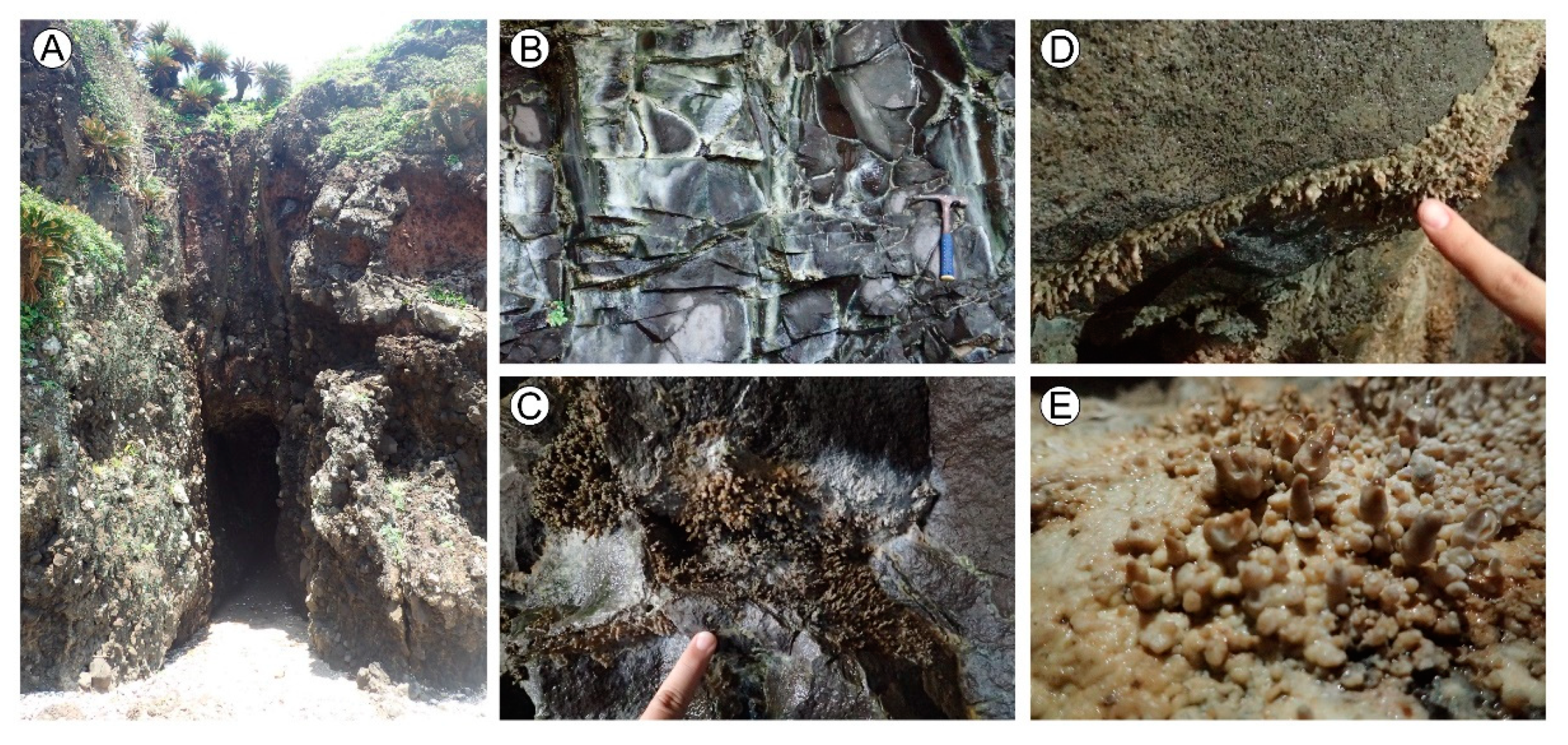
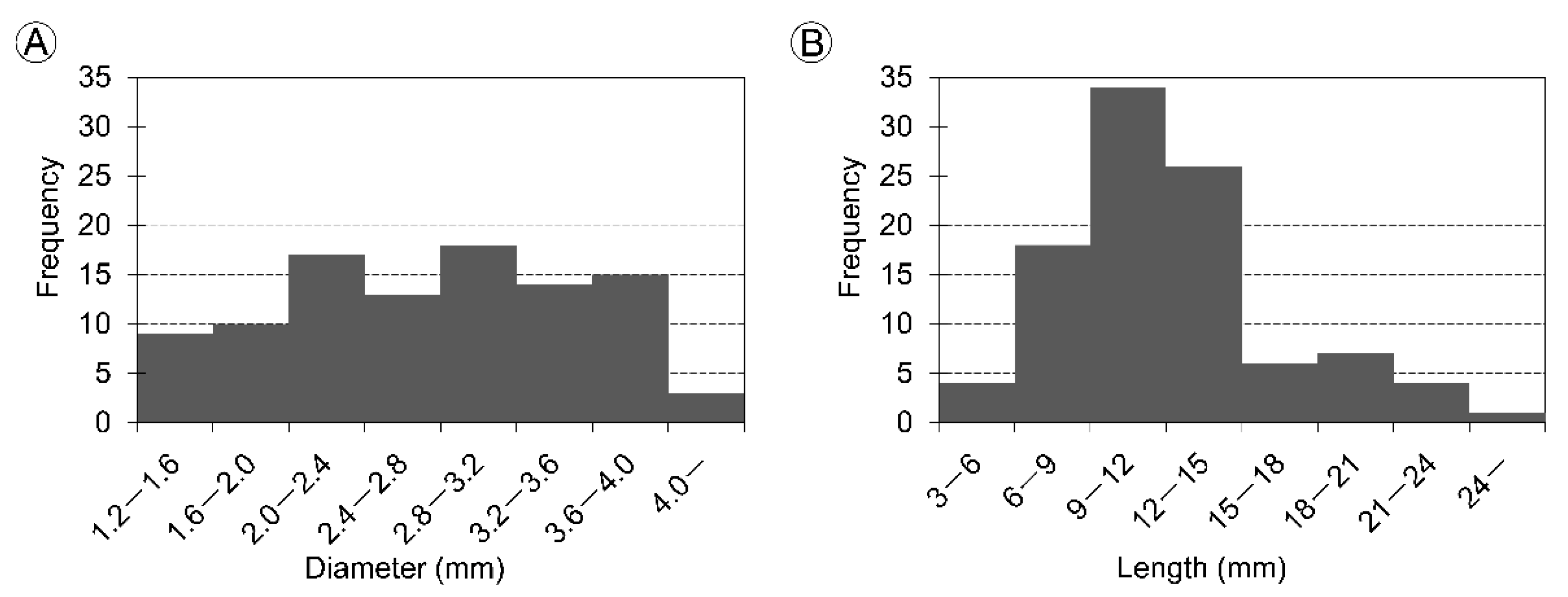


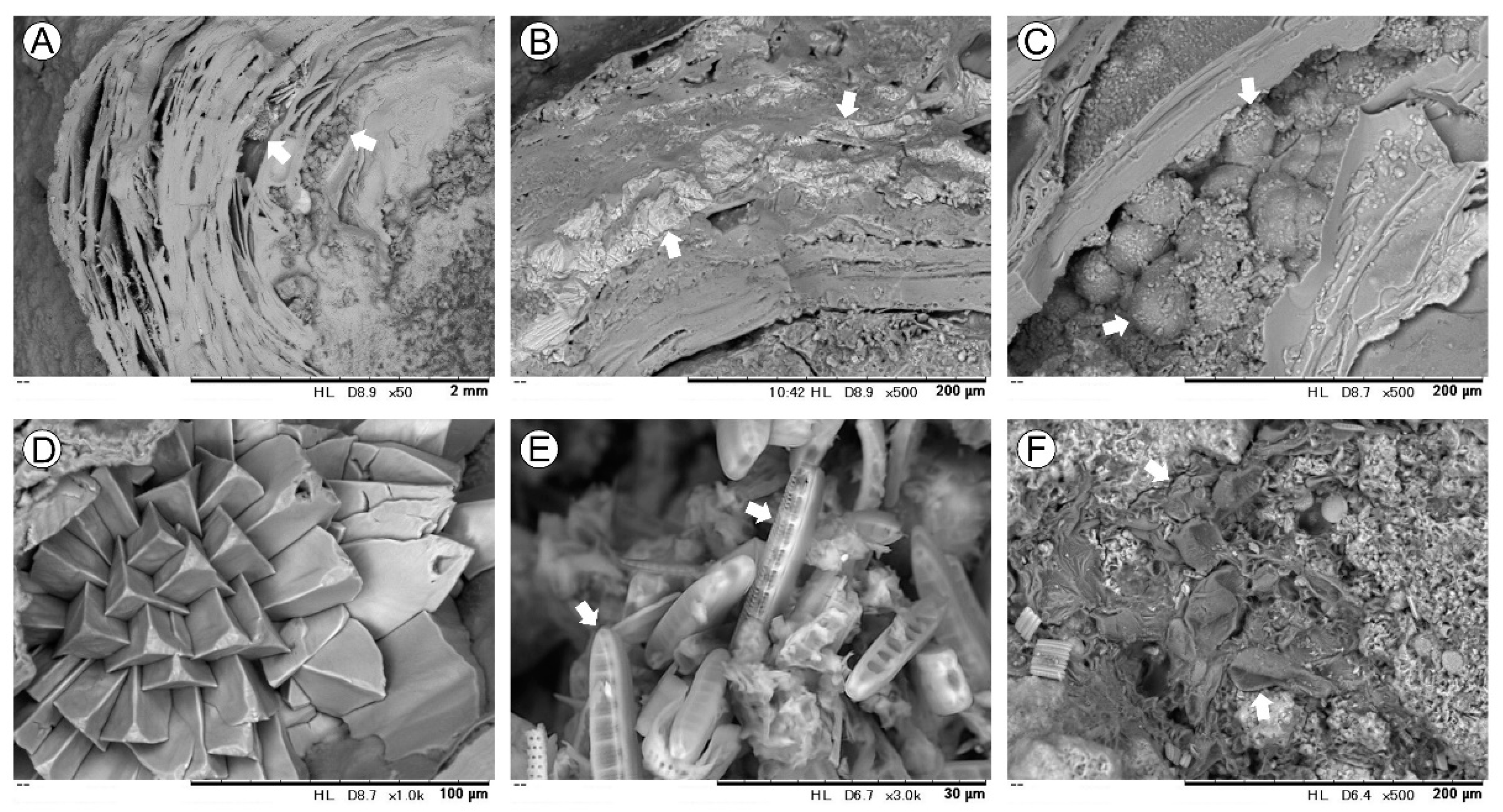
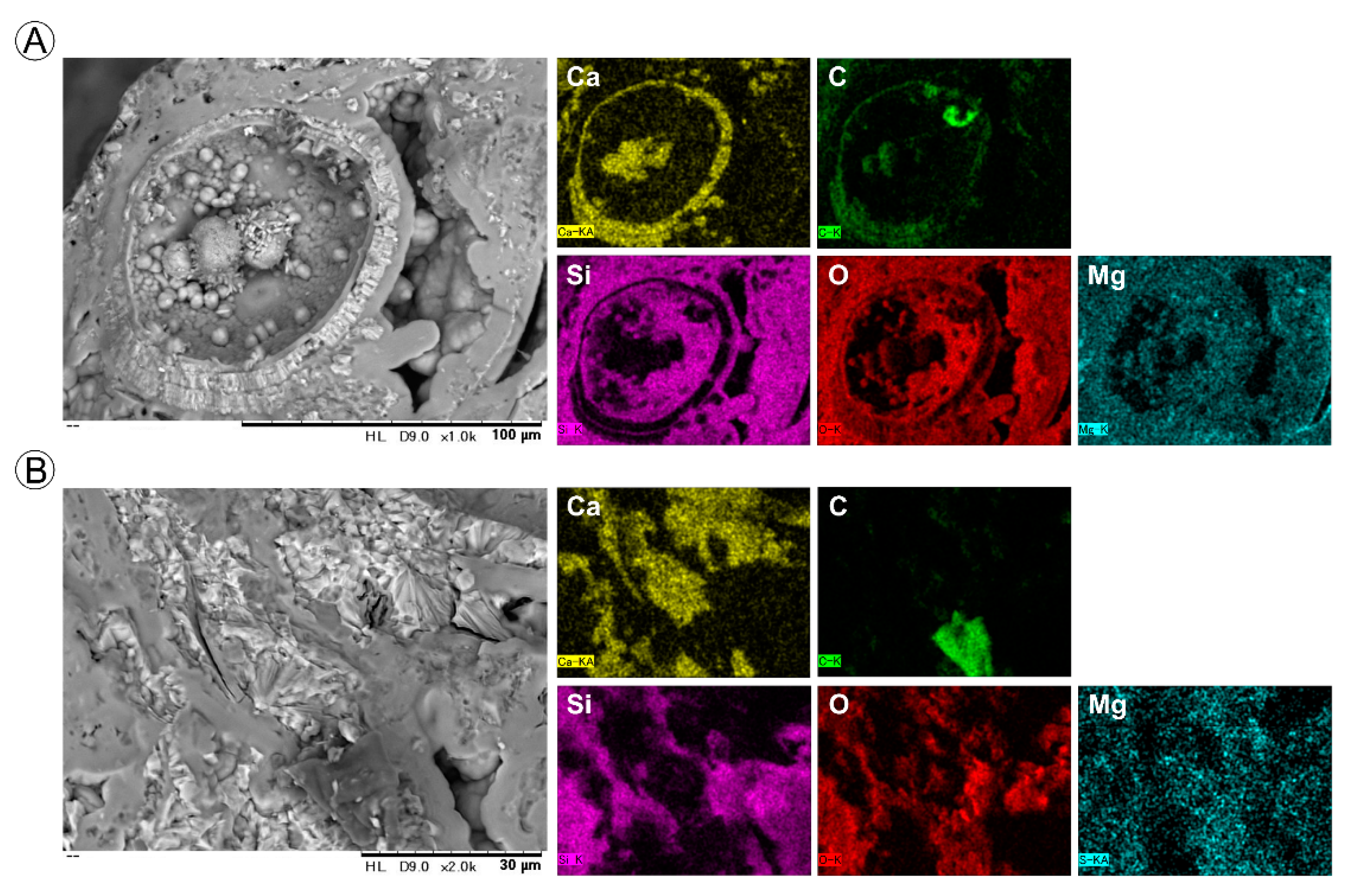
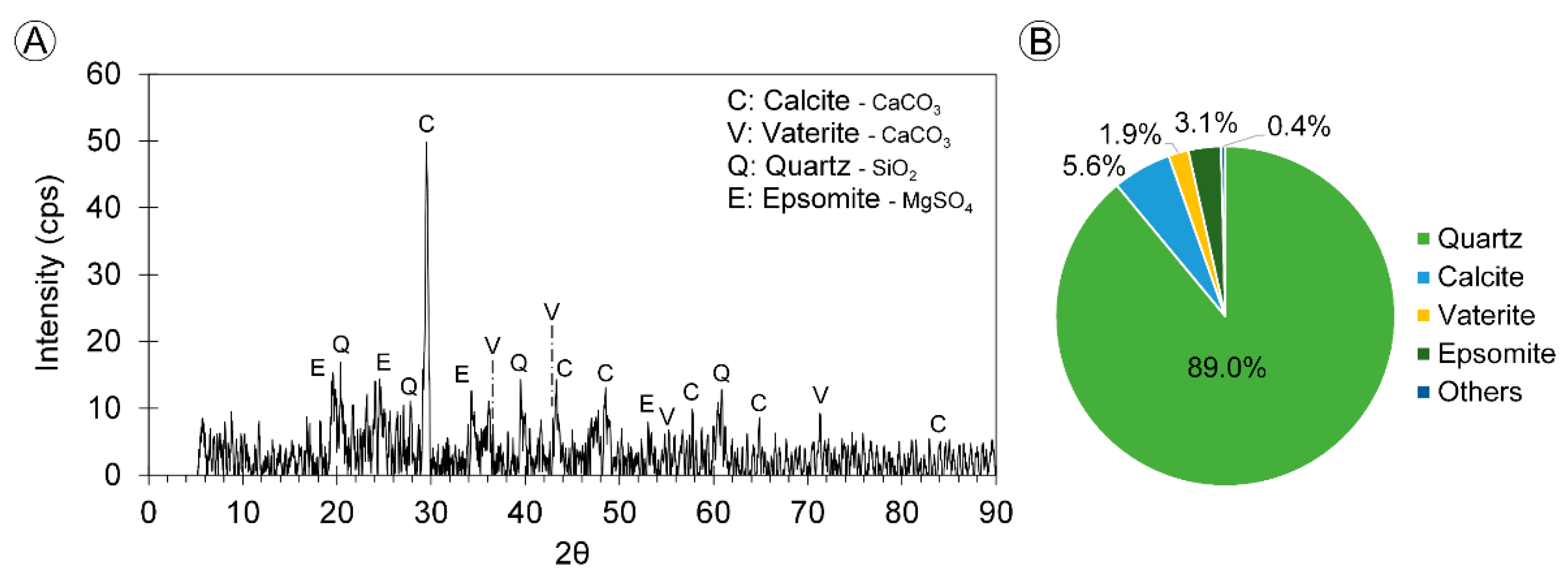

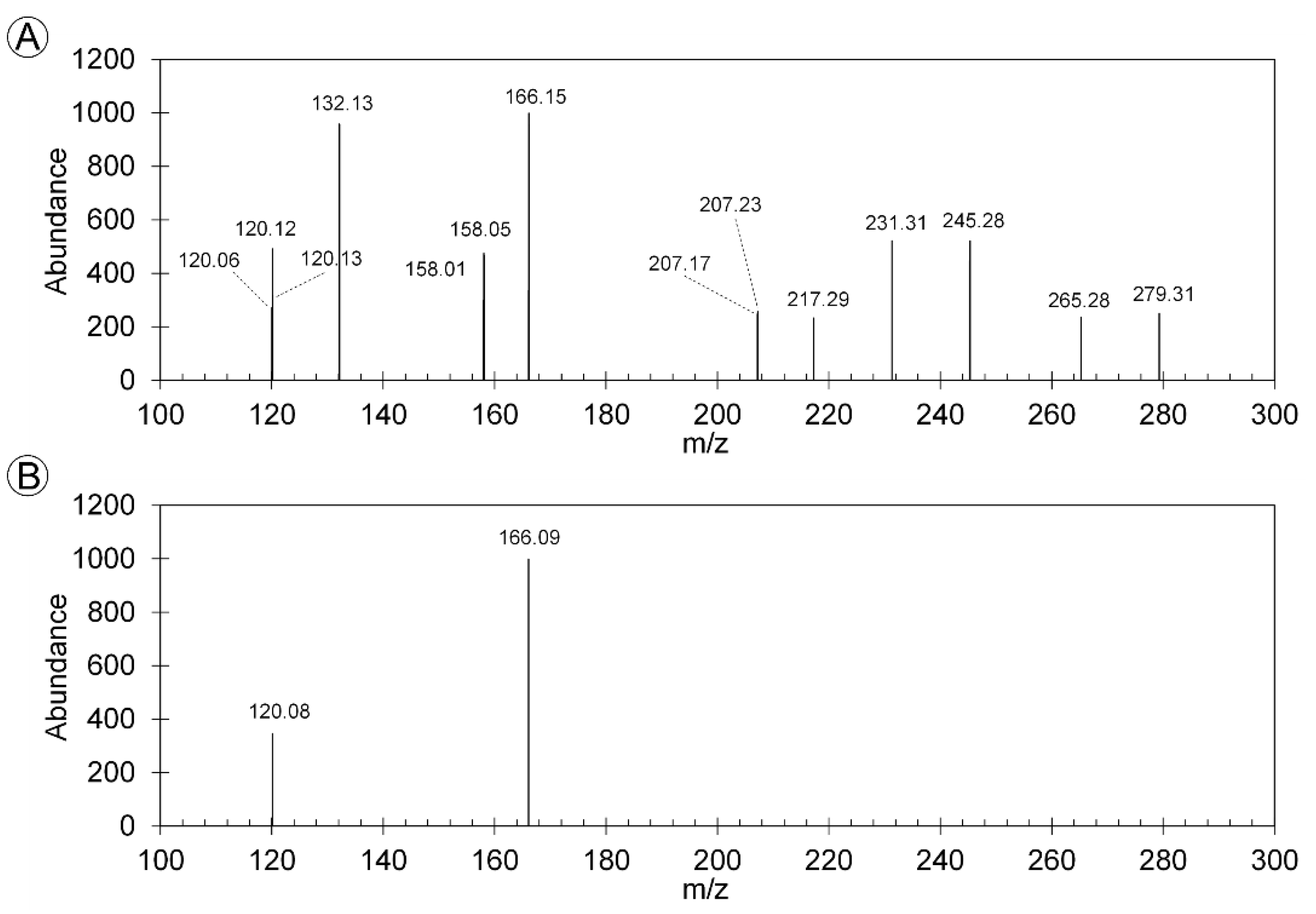
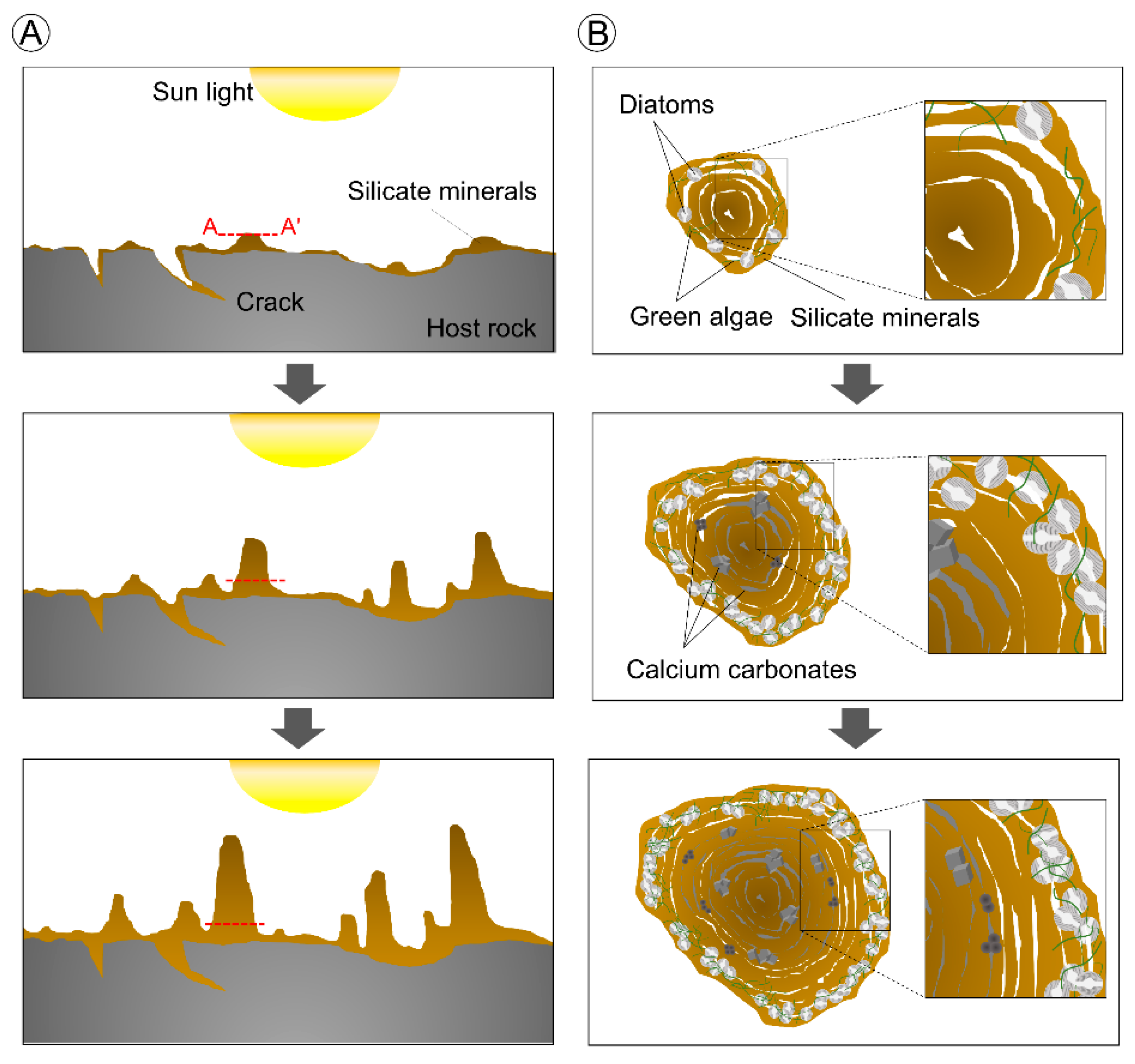
Publisher’s Note: MDPI stays neutral with regard to jurisdictional claims in published maps and institutional affiliations. |
© 2021 by the authors. Licensee MDPI, Basel, Switzerland. This article is an open access article distributed under the terms and conditions of the Creative Commons Attribution (CC BY) license (https://creativecommons.org/licenses/by/4.0/).
Share and Cite
Uenishi, R.; Matsubara, H. Calcium Carbonate Growth with the Ring Structure of Stalactite-Type Minerals in a Tuff Breccia. Crystals 2021, 11, 1117. https://doi.org/10.3390/cryst11091117
Uenishi R, Matsubara H. Calcium Carbonate Growth with the Ring Structure of Stalactite-Type Minerals in a Tuff Breccia. Crystals. 2021; 11(9):1117. https://doi.org/10.3390/cryst11091117
Chicago/Turabian StyleUenishi, Ryo, and Hitoshi Matsubara. 2021. "Calcium Carbonate Growth with the Ring Structure of Stalactite-Type Minerals in a Tuff Breccia" Crystals 11, no. 9: 1117. https://doi.org/10.3390/cryst11091117
APA StyleUenishi, R., & Matsubara, H. (2021). Calcium Carbonate Growth with the Ring Structure of Stalactite-Type Minerals in a Tuff Breccia. Crystals, 11(9), 1117. https://doi.org/10.3390/cryst11091117





